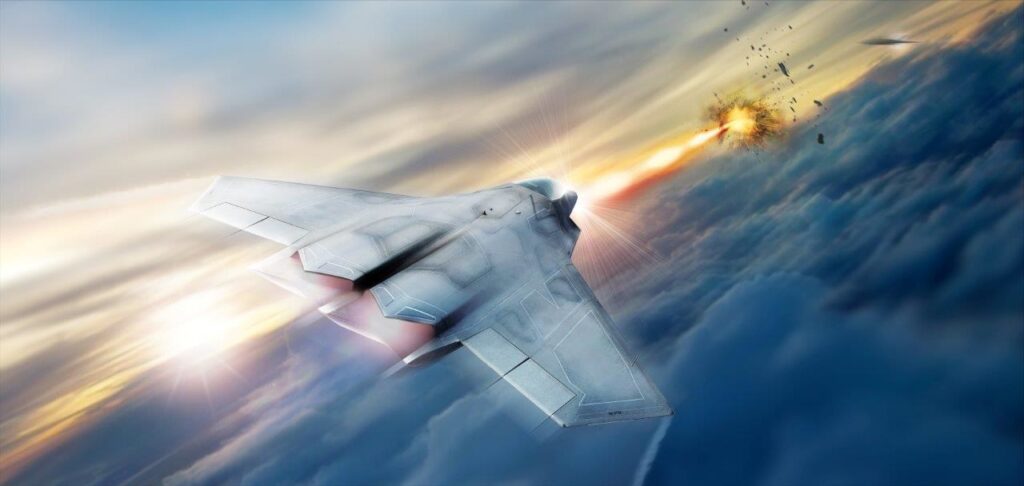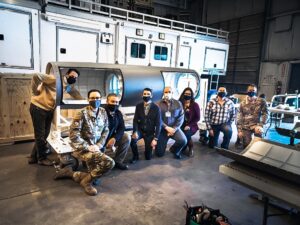
Lockheed Martin SHiELD concept.
WASHINGTON: The Air Force Research Laboratory’s experimental high-powered laser for aircraft self-defense will be revolutionary — if it can be made to work, experts say.
The first full-up flight test of the Self-Protect High Energy Laser Demonstrator (SHiELD) is now slated for 2024, Jeff Heggemeier, AFRL program manager, told Breaking D yesterday in an email. Some ground testing will be undertaken between now and then to “ensure system performance.” AFRL originally planned a flight test in 2021, last summer they pushed the date out to 2023.
“I would not oversell the capability. It is not going to work against every threat. There are many technological hurdles that need to be overcome, and there are countermeasures adversaries can employ to make a high-energy laser less effective,” summed up Todd Harrison, head of the Aerospace Security Project at the Center for Strategic and International Studies (CSIS).
Indeed, former DoD head of Research & Engineering Mike Griffin last year waxed highly skeptical about the viability of high-powered airborne lasers — especially for defense against ballistic missiles — but also at the short ranges that aircraft self-protection would require. Griffin cited power levels, beam stability in the face of atmospheric turbulence and even support requirements as difficult technical hurdles.
“It is a technical challenge to integrate a high power laser weapon with an aircraft for this type of mission, and SHiELD will be the first Air Force demonstration to prove that we have been able to address those challenges,” Heggemeier said in his email.
However, he argues that airborne laser self-defense weapons are ever more important because of efforts by peer adversaries (read Russia and China) “to build complex and layered air defenses intended to prevent our forces from being able to effectively penetrate and engage ground targets such as missiles left of launch.” SHiELD, he stressed “will provide greater defense capability against a wider range of incoming threats.” challenges.
The “many challenges” can be overcome “with time and money,” Harrison said. “They [the Air Force] already have systems that use lower powered lasers to blind the infrared sensors on missiles, so the ability to steer the beam and keep it on a target exists in the types of engagements we’re talking about here. The difficulty is doing that at a higher power level and maintaining focus and beam coherence,” he said. “Directed energy systems like this are likely the future of air and missile defense for airborne platforms because they can provide a much larger magazine of shots than kinetic interceptors. This is the most viable way to shift the cost exchange ratio in favor of the defender.”
Mark Gunzinger, director of future concepts at the Mitchell Institute, was enthusiastic about the future prospects for the program.
“It is great news!,” he said. “[I]ntegrating a laser weapon with a fast-moving, high-performance fighter is an incredibly difficult task when you consider the space, weight, power, and cooling limitations of the aircraft as well as how turbulence, high speed airflows, and other factors can impact a laser. These are AFRL-hard problems, and I think the fact it has overcome many of them says a lot about the overall maturity of directed energy weapons.”

Boeing now has delivered the first SHiELD pod to AFRL.
AFRL announced yesterday that it has received the first pod subsystem, built by Boeing, to carry the laser, and is awaiting delivery in July of the Lockheed Martin-built laser and the beam control system developed by Northrop Grumman. Lockheed Martin is the prime contractor.
“Over the past two years, the SHiELD team has seen major program milestones and technology maturation, including successfully flying an F-15 with attached laser test pod, and the successful shoot-down of air-launched missiles using a ground-based system configured to represent the laser system’s self-protect aspects,” Heggemeier said in the AFRL press release.
SHiELD is based on a “10s of kWs electric (solid state) laser,” Heggemeier told Breaking D, but said the exact power level and the range of the weapon is classified.
Solid state lasers can be much smaller and lighter than chemical lasers, such as that developed for the ill-fated Airborne Laser (ABL) program for shooting down ballistic missiles in the boost phase. (The ABL was too heavy for its platform, a modified Boeing 747, to carry and was killed in 2011 after DoD spend some $16 billion. It also made a huge and lumbering target.)
By contrast, the SHiELD pod is “consistent with the weight of standard pods on an F-15,” Heggemeier said in his email. “The base design (size, shape, and weight) was based on the 610-gallon fuel tank standard to some AF aircraft.”
Harrison said that if the laser system proves proves successful for aircraft self-defense, there are other useful missions for a solid-state laser weapon. “If you think farther out into the future, this technology could be used on a stealthy drone that gets deployed by an aircraft. The drone could fly out ahead and shoot down targets, including other aircraft and drones, to essentially clear the airspace and establish air superiority before the strike platforms enter the area,” he said. “The technology could also one day be adapted to space platforms to defend against direct-ascent and co-orbital ASAT weapons.”
Gunzinger agreed. “Along with THOR and several other developmental systems nearing maturity, it’s tangible evidence that our warfighters will soon have a new class of weapons that can create multiple effects on targets at light speed. Kelly Hammett [director of AFRL’s Directed Energy Directorate] is exactly right when he said [in AFRL’s release] high energy lasers, high power microwave systems, and other DE capabilities will be game changers.”
Air Force awards SNC $13B contract for new ‘Doomsday’ plane
The win is a major victory for the firm in a competition that saw the surprise elimination of aerospace giant Boeing.


























